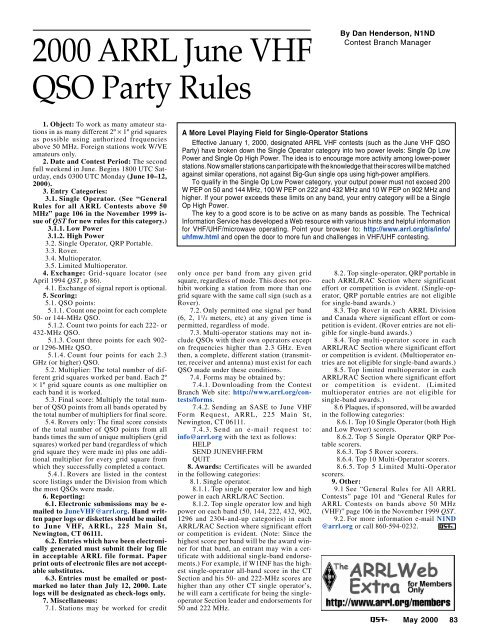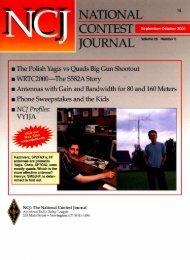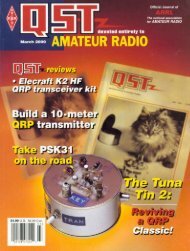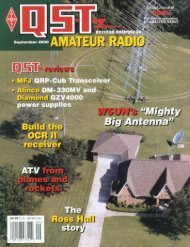their 432 MHz triumph of the previous yearwhile the seasoned crew at ON5RR nabbedthe top spot on 1296 MHz, up from theirthird place finish of 1998. Special congratulationsto the team at OK1KIR whomanaged to snare three QSOs on 5760 MHzduring the contest.So roll call at the EME Competition wascomplete with several hundred officers reportingin from various precincts. All tookgreat care in trying to dig out the evidenceof completed QSOs on what is a verydifficult “case” to be assigned. Rookies tothe event learned new ways to patrol the beat.Judging from the number of QSOs reported,interest in this type operation is on the increase.No arrests will be made from among thesuspects, but all of the participants are tobe commended for outstanding efforts atplying the tools of the trade to make thisDL7MAT operating at DL5MAE.another successful event. Come this fall, the“Old Man” will send out the word that thesleuths of the EME beat are to assemble andtrack down the faint signals. Watch for theannouncement in September’s <strong>QST</strong>. Untilthen, “let’s be careful out there.”ScoresEach line score lists call sign, score, stations worked, multipliers, and band (A= 50 MHz, B = 144 MHz, C = 222 MHz, D = 432 MHz, 9 = 902 MHz, E = 1296 MHz, F = 2304 MHz, I= 10 GHz).Single Operator, MultibandK5GW 2,763,000 212 50 B88 34 D7 6 EOE5EYM 1,502,300 80 33 B54 24 D47 26 EN2IQU 1,008,000 101 36 D59 27 EOZ4MM 942,400 91 33 D60 28 E1 1 FSM3AKW 509,600 4 4 B44 22 D50 26 EVE1ALQ 434,000 1 1 B27 25 D40 34 E2 2 HDK3WG 427,200 39 24 B50 24 DCT1DMK 424,000 35 21 B20 13 D25 19 EG3LTF 394,800 46 24 D36 21 E2 2 FEA3DXU 344,000 47 24 B33 19 DKD4LT 290,400 36 21 D30 23 EOZ6OL 287,000 31 18 D39 23 EHA1YA 210,000 6 6 B54 29 DOH2DG 187,200 25 16 D26 19 E1 1 FVE6TA 176,000 38 20 D17 12 EJA5NNS 143,100 9 6 B44 21 DW7SZ 128,000 23 18 D17 14 EYO2IS 114,800 23 16 B18 12 DW5LUA 112,000 32 20 E2 2 F2 2 H4 4 IW4AD 105,600 36 19 B8 5 ES51ZO 62,000 17 10 B14 10 DWB0GGM 56,000 18 13 B10 7 DN3FA 43,700 17 14 B6 5 DJH0WJF 35,200 13 8 B9 8 DW7GJ 24,000 2 2 A18 10 BJA4BLC 18,200 2 2 B5 4 D6 6 E1 1 FJH0BBE 1,600 1 1 B3 3 DSingle Operator, 144 MHzSM5FRH 1,920,000 320 60 BW5UN 1,711,000 290 59 BSM5BSZ 1,026,000 190 54 BI2FAK 798,700 163 49 BVE3KH 733,200 156 47 BOZ1HNE 629,800 134 47 BIK1FJI 544,500 121 45 BW0HP 479,600 109 44 BDL5MAE 473,000 110 43 BSM7SJR 459,200 112 41 BPA2CHR 450,000 100 45 BLZ2US 449,400 107 42 BG3ZIG 417,300 107 39 B7K3LGC 331,200 92 36 BK6MYC 291,600 81 36 BK1CA 248,500 71 35 BF6BSJ 234,500 67 35 BDK9ZY 231,000 77 30 BK0FF 223,200 72 31 BK5AIH 217,600 64 34 BN2WK 201,300 61 33 BEA2AGZ 176,000 55 32 BEA6VQ 155,000 50 31 BIV3GBO 132,600 51 26 BDL2MHS 126,900 47 27 BW0PT 124,000 40 31 BPE1OGF 117,500 47 25 BS52LM 110,400 46 24 BJA6AHB 110,400 46 24 BSM2BYA 107,500 43 25 BJH5FPQ 101,200 44 23 BSM5CFS 94,300 41 23 BDL7MAT 86,400 36 24 BJH2COZ 70,300 37 19 BLA9NEA 68,000 40 17 BSP7DCS 66,000 33 20 BSV1BTR 65,100 31 21 BWB4JEM 62,700 33 19 BI2RV 62,000 31 20 B9A9B 58,900 31 19 BUA4AAV 57,000 30 19 BWA1JOF 57,000 30 19 BPA3CWI 56,000 28 20 BW0VD 51,300 27 19 BWA6PY 48,600 27 18 BDL2IAN 44,800 28 16 BPE1LWT 44,200 26 17 BI1ANP 40,000 25 16 BF9HS 38,400 24 16 BW6OMF 35,700 21 17 BJ6/K6MYC 34,500 23 15 BW3SZ 32,200 23 14 BK7YVZ 32,200 23 14 BS51UE 29,400 21 14 BSP2JXN 28,600 22 13 BJR3REX 24,000 20 12 BVK3CY 23,400 18 13 BEA1ABZ 22,100 17 13 BDL2OM 22,100 17 13 BN0AKC 22,000 20 11 BKV6J 20,800 16 13 BYO2AMU 19,800 18 11 BWA3BZT 18,000 15 12 BDJ3MY 18,000 15 12 BI3EVK 15,000 15 10 BJH0ISW 13,000 13 10 BF8DO 12,800 16 8 BSM4HFI 12,000 12 10 BJK1HIX 11,700 13 9 BW0EKZ 11,700 13 9 BK7MAC 11,000 11 10 BSV4BGY 10,800 12 9 BYO2II 9,100 13 7 BN1RWY 7,000 10 7 BJR5JXV 6,300 9 7 BUA3DJG 6,000 10 6 BW7OE 5,400 9 6 B8J1RL (JA9BOH, op)4,200 7 6 BJA8LLE 2,500 5 5 BW9JN 2,000 5 4 BW5UWB 1,800 6 3 BVE3EQQ 1,600 4 4 BN6ZE 1,600 4 4 BF6CRP 1,200 4 3 BW3EP/1 1,200 4 3 BG4DOL 900 3 3 BK6AAW 900 3 3 BEA1BFZ 900 3 3 BJF4TGD/8 400 2 2 BW4LNG 400 2 2 BAL7EB 400 2 2 BWB0OAJ 400 2 2 BLY2SA 400 2 2 BSM0NKZ 400 2 2 BDK5YA 100 1 1 B7J7ADB (KG6DX, op)100 1 1 BAC3A 100 1 1 BPA3BUT 100 1 1 BSingle Operator, 432 MHzDL9KR 413,000 118 35 DK1FO 392,000 112 35 DDL9NDD 367,200 108 34 DDF3RU 339,900 103 33 DN9AB 313,500 95 33 DK0RZ 234,000 78 30 DDL4MEA 229,400 74 31 DDJ6MB 226,200 78 29 DG3SEK 222,000 74 30 DON5OF 137,500 55 25 DON4KNG 98,900 43 23 DK5WXN 92,400 44 21 D7M2PDT 88,000 44 20 DG4ERG 69,300 33 21 DJH4JLV 68,400 36 19 DDL1YMK 51,200 32 16 DW8MQW 51,000 30 17 DS52CW 38,400 24 16 DDL3EAG 25,200 21 12 DDK3FB 23,100 21 11 DUT3LL 22,400 16 14 DJJ1NNJ 21,600 18 12 DIK5WJD 21,600 18 12 DIK5QLO 20,800 16 13 DJA2TY 16,500 15 11 DJR1RCH 6,300 9 7 DKB0VUK 3,000 6 5 DJH1EFA 1,600 4 4 DK6JEY 400 2 2 DSingle Operator, 1296 MHzK5JL 247,500 75 33 EK4QI 195,000 65 30 EHB9BBD 191,400 66 29 EF5PAU 167,400 54 31 EOH2AXH 162,400 58 28 EK2DH 140,000 50 28 EW2UHI 135,200 52 26 EEA3UM 112,800 47 24 EDJ5MN 110,000 44 25 EOK1DFC 98,800 38 26 EK3HZO 96,000 40 24 EJH5LUZ 71,400 34 21 EJA6CZD 64,000 32 20 EDH9FAG 54,600 26 21 EW3XS 47,600 28 17 EWA4OFS 19,200 16 12 EW7QX 13,000 13 10 EWD5AGO 12,000 12 10 EJF3HUC 200 2 1 EMultioperator, MultibandJL1ZCG (JH1DYV, JR4ENY, JE8IVF, ops)1,088,000 102 38 B68 26 DW6TE (+WA6LUT)16,500 14 10 B1 1 DMultioperator, 144 MHzKB8RQ (+N8DFN)1,563,500 265 59 BIK3MAC (+I3YXQ)1,339,200 248 54 BF3VS (+F8PKC, F5JTA)1,276,000 232 55 BHB9Q (HB9CRQ, HB9DBM, ops)697,500 155 45 BR1MVZ (RU1AA, RN1AM,ops)444,600 117 38 BS53J (S57EA, S53OQ, S56TZJ, ops)115,000 46 25 BVE2JWH (+VE2GUQ, VE2AAY, VE2SMG)67,200 32 21 BF1DDG (+F6HEO)30,000 20 15 BHB9MS (HB9OCW, HB9SUL, ops)16,500 15 11 BKK5IH (+KK5KK)4,800 8 6 BW6YX (W6QI, AD6FP, ops)3,000 6 5 BMultioperator, 432 MHzOH2PO (+OH6DD)414,800 122 34 DF5FLN (+F6IRA, F5FVP, F6ARU)171,600 66 26 DDJ3FI (+DL1EJA)42,000 28 15 DF1CH (+F5SDD, F5IVP)32,400 18 18 DDK0MM (DL4ZAG, DL2FCN,ops)2,800 7 4 DMultioperator, 1296 MHzON5RR (+ON7EH)81,400 37 22 EWA9OUU (+WB8IFM, W8ULC, N8VZW,KB8UHY)42,500 25 17 EHA5SHF (+HA5BGL, HA5BMU)16,800 14 12 EKB4FEM (+W4JSS, N4SZ, KJ4X, KK4SO,N4AK, WA5AMM)400 2 2 EMultioperator, 5760 MHzOK1KIR (+OK1DAI, OK1DAK)600 3 2 H82 <strong>May</strong> <strong>2000</strong>
<strong>2000</strong> ARRL June VHFQSO Party RulesBy Dan Henderson, N1NDContest Branch Manager1. Object: To work as many amateur stationsin as many different 2º × 1º grid squaresas possible using authorized frequenciesabove 50 MHz. Foreign stations work W/VEamateurs only.2. Date and Contest Period: The secondfull weekend in June. Begins 1800 UTC Saturday,ends 0300 UTC Monday (June 10–12,<strong>2000</strong>).3. Entry Categories:3.1. Single Operator. (See “GeneralRules for all ARRL Contests above 50MHz” page 106 in the November 1999 issueof <strong>QST</strong> for new rules for this category.)3.1.1. Low Power3.1.2. High Power3.2. Single Operator, QRP Portable.3.3. Rover.3.4. Multioperator.3.5. Limited Multioperator.4. Exchange: Grid-square locator (seeApril 1994 <strong>QST</strong>, p 86).4.1. Exchange of signal report is optional.5. Scoring:5.1. QSO points:5.1.1. Count one point for each complete50- or 144-MHz QSO.5.1.2. Count two points for each 222- or432-MHz QSO.5.1.3. Count three points for each 902-or 1296-MHz QSO.5.1.4. Count four points for each 2.3GHz (or higher) QSO.5.2. Multiplier: The total number of differentgrid squares worked per band. Each 2º× 1º grid square counts as one multiplier oneach band it is worked.5.3. Final score: Multiply the total numberof QSO points from all bands operated bythe total number of multipliers for final score.5.4. Rovers only: The final score consistsof the total number of QSO points from allbands times the sum of unique multipliers (gridsquares) worked per band (regardless of whichgrid square they were made in) plus one additionalmultiplier for every grid square fromwhich they successfully completed a contact.5.4.1. Rovers are listed in the contestscore listings under the Division from whichthe most QSOs were made.6. Reporting:6.1. Electronic submissions may be e-mailed to JuneVHF@arrl.org. Hand writtenpaper logs or diskettes should be mailedto June VHF, ARRL, 225 Main St,Newington, CT 06111.6.2. Entries which have been electronicallygenerated must submit their log filein acceptable ARRL file format. Paperprint outs of electronic files are not acceptablesubstitutes.6.3. Entries must be emailed or postmarkedno later than July 12, <strong>2000</strong>. Latelogs will be designated as check-logs only.7. Miscellaneous:7.1. Stations may be worked for creditA More Level Playing Field for Single-Operator StationsEffective January 1, <strong>2000</strong>, designated ARRL VHF contests (such as the June VHF QSOParty) have broken down the Single Operator category into two power levels: Single Op LowPower and Single Op High Power. The idea is to encourage more activity among lower-powerstations. Now smaller stations can participate with the knowledge that their scores will be matchedagainst similar operations, not against Big-Gun single ops using high-power amplifiers.To qualify in the Single Op Low Power category, your output power must not exceed 200W PEP on 50 and 144 MHz, 100 W PEP on 222 and 432 MHz and 10 W PEP on 902 MHz andhigher. If your power exceeds these limits on any band, your entry category will be a SingleOp High Power.The key to a good score is to be active on as many bands as possible. The TechnicalInformation Service has developed a Web resource with various hints and helpful informationfor VHF/UHF/microwave operating. Point your browser to: http://www.arrl.org/tis/info/uhfmw.html and open the door to more fun and challenges in VHF/UHF contesting.only once per band from any given gridsquare, regardless of mode. This does not prohibitworking a station from more than onegrid square with the same call sign (such as aRover).7.2. Only permitted one signal per band(6, 2, 1 1 /4 meters, etc) at any given time ispermitted, regardless of mode.7.3. Multi-operator stations may not includeQSOs with their own operators excepton frequencies higher than 2.3 GHz. Eventhen, a complete, different station (transmitter,receiver and antenna) must exist for eachQSO made under these conditions.7.4. Forms may be obtained by:7.4.1. Downloading from the ContestBranch Web site: http://www.arrl.org/contests/forms.7.4.2. Sending an SASE to June VHFForm Request, ARRL, 225 Main St,Newington, CT 06111.7.4.3. Send an e-mail request to:info@arrl.org with the text as follows:HELPSEND JUNEVHF.FRMQUIT8. Awards: Certificates will be awardedin the following categories:8.1. Single operator.8.1.1. Top single operator low and highpower in each ARRL/RAC Section.8.1.2. Top single operator low and highpower on each band (50, 144, 222, 432, 902,1296 and 2304-and-up categories) in eachARRL/RAC Section where significant effortor competition is evident. (Note: Since thehighest score per band will be the award winnerfor that band, an entrant may win a certificatewith additional single-band endorsements.)For example, if W1INF has the highestsingle-operator all-band score in the CTSection and his 50- and 222-MHz scores arehigher than any other CT single operator’s,he will earn a certificate for being the singleoperatorSection leader and endorsements for50 and 222 MHz.8.2. Top single-operator, QRP portable ineach ARRL/RAC Section where significanteffort or competition is evident. (Single-operator,QRP portable entries are not eligiblefor single-band awards.)8.3. Top Rover in each ARRL Divisionand Canada where significant effort or competitionis evident. (Rover entries are not eligiblefor single-band awards.)8.4. Top multi-operator score in eachARRL/RAC Section where significant effortor competition is evident. (Multioperator entriesare not eligible for single-band awards.)8.5. Top limited multioperator in eachARRL/RAC Section where significant effortor competition is evident. (Limitedmultioperator entries are not eligible forsingle-band awards.)8.6 Plaques, if sponsored, will be awardedin the following categories:8.6.1. Top 10 Single Operator (both Highand Low Power) scorers.8.6.2. Top 5 Single Operator QRP Portablescorers.8.6.3. Top 5 Rover scorers.8.6.4. Top 10 Multi-Operator scorers.8.6.5. Top 5 Limited Multi-Operatorscorers.9. Other:9.1 See “General Rules for All ARRLContests” page 101 and “General Rules forARRL Contests on bands above 50 MHz(VHF)” page 106 in the November 1999 <strong>QST</strong>.9.2. For more information e-mail N1ND@arrl.org or call 860-594-0232.<strong>May</strong> <strong>2000</strong> 83
- Page 6 and 7:
May 2000 Volume 84 Number 5David S
- Page 11 and 12:
THE AMERICAN RADIORELAY LEAGUE INC
- Page 14:
Get to Know Your Section ManagerThe
- Page 18:
The ARRL and the FCC’s Private Wi
- Page 22 and 23:
The postman always keys twice.Accor
- Page 26 and 27:
CORRESPONDENCEYour opinions count!
- Page 30 and 31:
By Ian Poole, G3YWXOperating in the
- Page 32 and 33:
By Roger Sullivan, WA0ETE, and Hugh
- Page 34 and 35: By Jim Graver, KB8PSO2000Dayton Ham
- Page 36 and 37: Figure 1A—Schematic of the interf
- Page 38 and 39: All input/output connections are ma
- Page 40 and 41: Figure 4—Hanger loopconstruction.
- Page 42 and 43: Figure 2—A GOES-8 picture capture
- Page 44 and 45: By Steve Ford, WB8IMYPSK31 2000In e
- Page 46 and 47: the software, PSK31 tuning required
- Page 48 and 49: WORKBENCHPROJECTS AND INFORMATION F
- Page 50 and 51: By Martin A. Minow, K6MAMPractice M
- Page 52 and 53: the download to a suitable location
- Page 54 and 55: 52 May 2000SHORT TAKESHeil Sound Go
- Page 56 and 57: By Zack Lau, W1VTA No-Tune 2-Meter
- Page 58 and 59: HINTS & KINKSA FOLD-DOWN MOBILE-ANT
- Page 60 and 61: By James Kates, N9GBBConfessions of
- Page 62 and 63: PRODUCT REVIEWKenwood TM-D700A Dual
- Page 64 and 65: is accomplished by using OK, BACK a
- Page 66 and 67: other radio operation. The chatter
- Page 68 and 69: operation because there’s so litt
- Page 70 and 71: consideration in the WT Docket 98-1
- Page 72 and 73: News in Brief:• League members no
- Page 74 and 75: communications tests in celebration
- Page 76 and 77: I’ve done this tour several years
- Page 78 and 79: The Crystal Symphony at anchor off
- Page 80 and 81: Table 1Claimed North American Dista
- Page 82 and 83: Okay in My LogBy Vic Curtis,WA3YUVP
- Page 86 and 87: 2000 ARRL Field DayRulesBy Dan Hend
- Page 88 and 89: Collecting Vintage QSLsOLD RADIOAn
- Page 90 and 91: DIGITAL DIMENSIONAPRS Digipeater in
- Page 92 and 93: AT THE FOUNDATIONWhy We Fund Museum
- Page 94 and 95: It is with deep regret that we reco
- Page 96 and 97: COMING CONVENTIONSARRL NATIONAL CON
- Page 98 and 99: checking; handicapped accessible; f
- Page 106: of the West Allis ARC and served as
- Page 110: introduced that could of had a bear
- Page 114: 211/109; NJN/L 29/203/103; CJTN 29/
- Page 118: W1PEX 1048, WA1JVV 143, N1NH 105, W
- Page 124: an activity we enjoy so much can be
- Page 128: 126He is President of the Amateur R
- Page 132: is Walt Bacon, N6SMT, who is curren
- Page 150:
Ham Adsl) Advertising must pertain
- Page 154:
BAHAMAS RENTAL: Abaco villa w/stati
- Page 164:
“EVERYTHING FOR THE MORSE ENTHUSI
- Page 168:
TUBES WANTED: Highest prices paid o
















